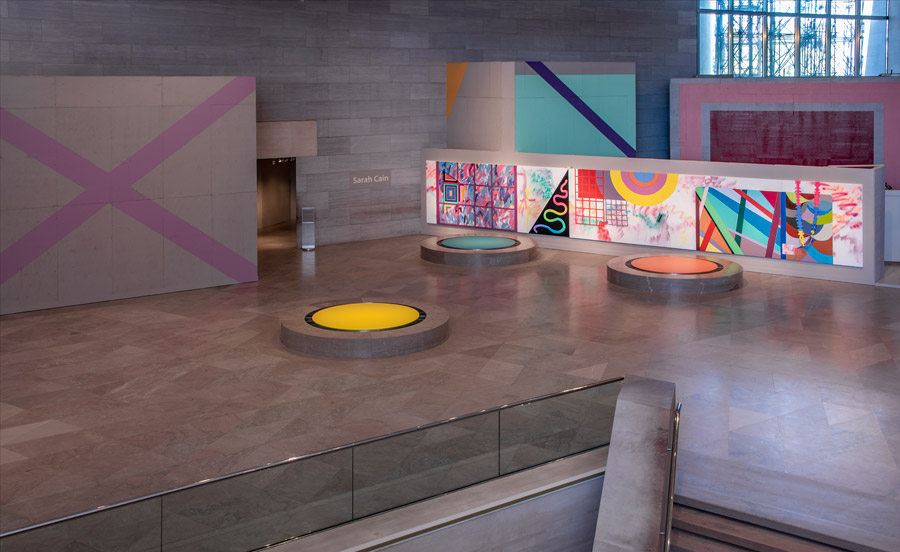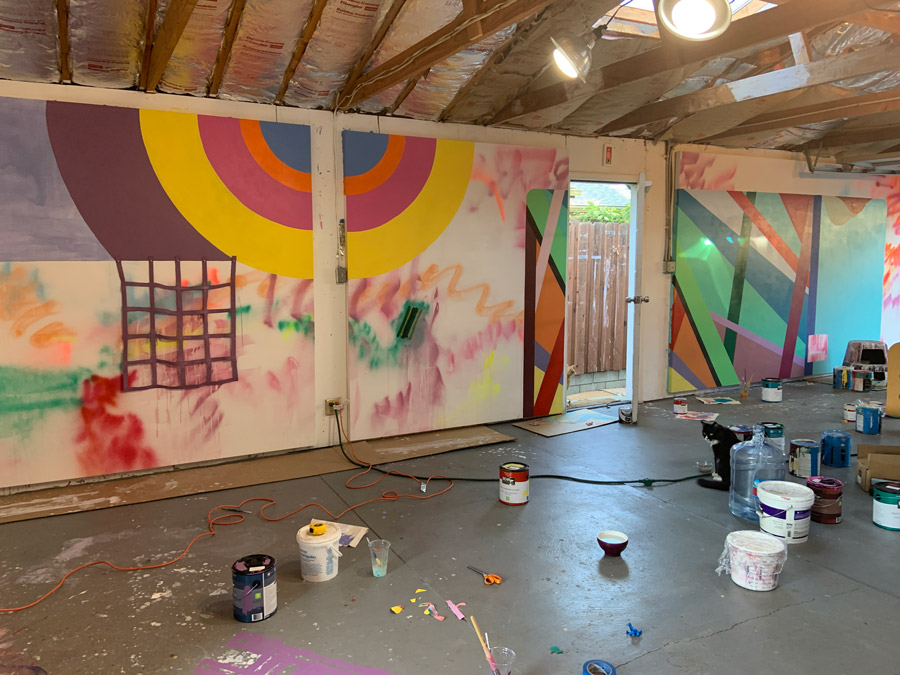The National Gallery commissioned three artists—Sarah Cain, Avish Khebrehzadeh, and Kay Rosen—to transform temporary construction walls and empty spaces inside and outside the East Building into places for site-responsive installations for Artist Projects. Cain created My favorite season is the fall of the patriarchy, a 45-foot-long abstract painting installed on a temporary wall that protects permanent collection sculptures.
In this interview, Sarah Cain discusses the inspiration and philosophy behind her work.
Tell us about your work. What’s the story behind its title?
My installation has a lot of different components that bounce through the space, as well as a very large painting that I created in my studio in Los Angeles. The title came from an image of a coffee mug that read, "My Favorite Season Is the Fall of the Patriarchy." I thought it was funny, and it reflects the fierce feminism and humor in my work.
The title resonated for me also because the East Building Atrium typically has on view lots of sculptures by men. Very few women artists have been represented in the space before, and I was conscious of that throughout the project. In a symbolic way, it was like these old, dead masters were having to make room for contemporary women artists to come in. It was very exciting.

Sarah Cain’s work installed in the East Building Atrium
How did you create a site-responsive installation without being in the space?
Normally, I visit a place when I’m planning to make a work onsite, but the East Building was under construction. It didn’t really make sense for me to go. The space kept changing, which would have made planning difficult.
Originally, I was going to do all the painting onsite. After the pandemic hit, we had to pivot and change. I couldn’t visit the space, but I still had to investigate it through photos and FaceTime.
This change in plan taught me how to make something that relates to a site and expands onto it without my having to be there. I worked on plans through text messages, and I did drawings and sent them back and forth while working with a team.
I made the painting at my studio in Los Angeles. Because of space limitations, I had to make it on seven canvases that wrapped in a circle around every single wall space I had. I didn’t work out the dimensions in my studio beforehand. A lot of my work is intuitive. I have a really good sense of scale, and I don’t plan too much. Fluidity, spontaneity, and an element of chance, plus trial and error, add freshness to my practice. It was an amazing experience.

Cain created My favorite season is the fall of the patriarchy in her Los Angeles studio.
What excited you most about making My favorite season is the fall of the patriarchy?
For 15 years or more I’ve made ephemeral works onsite, large works that get destroyed. I am okay with that—I think it keeps the practice active in the present tense—but it is also a shame. A few years ago I realized I’ve made over 50 works that have been destroyed.
One exciting part with My favorite season is the fall of the patriarchy is that the painting lives on afterward. It is really detailed, with hand sewing and lots of beads. I let the painting tell me what to do. I always surprise myself.
While doing this painting for the National Gallery, I realized I’m meant to work large. Scale doesn’t bother me. It excites me. A painting this large is very physical and comes out of the body. To have this painting in this venue—the East Building Atrium, an epic cave—is truly exciting.
Banner image: Sarah Cain, My favorite season is the fall of the patriarchy, 2021, acrylic, rope, beads, thread, silver leaf, gold leaf, and paint rollers, Courtesy of the Artist
